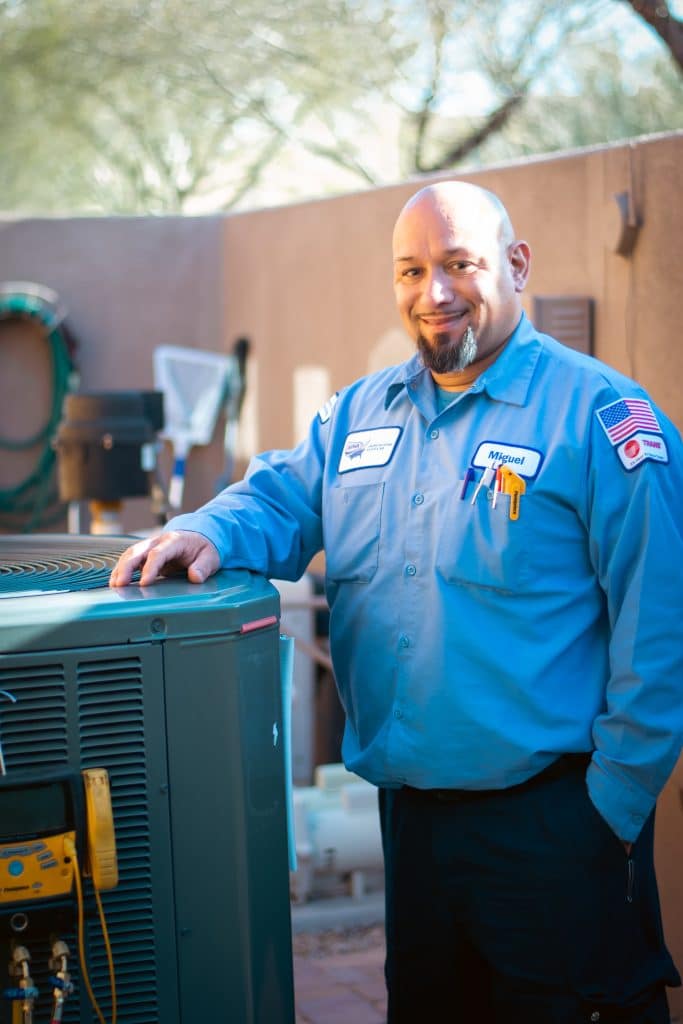What Is A Good SEER Rating?
Need Help Now? Call Us 24/7
What Are SEER Ratings?
As we mentioned above, SEER stands for Seasonal Energy Efficiency Ratio. . Much like car mileage, a SEER rating’s real-life ramifications depend on the conditions in which you use the machine. In other words, an air conditioner’s rating represents its maximum performance.
In the American Southwest (including Phoenix, Arizona), the U.S. Department of Energy mandates that new air conditioners have SEER ratings of no less than 14. This makes new air conditioners automatically much more efficient than old ones, which typically have air conditioning SEER ratings of 8 or 9.
SEER ratings for AC go all the way up to 20 for those with a particular penchant for efficiency. At American Home Water and Air, we provide the best air conditioning and HVAC services in Phoenix, AZ. We strive for 100% transparency in our pricing – you can find out all about our HVAC unit installation prices via this calculator.
Calculating SEER Ratings, Explained
There’s no perfect SEER rating for every home. Rather, choosing the right SEER rating depends on several factors. Here’s a rundown on how we calculate it in the HVAC industry.
Step 1: Calculate Your Yearly AC Usage
Follow these steps to determine how many watt-hours a given air conditioner uses.
First, multiply your air conditioner’s size by 12,000.
An air conditioner’s size is typically referenced in tons. Each ton represents 12,000 British Thermal Units (BTUs) or cooling power. What’s a BTU? Well, it’s simply the amount of energy used to raise a pound of water by a single degree Fahrenheit.
Next, take that number and divide it by the air conditioner’s SEER rating.
This will give you the amount of Watts your air conditioner uses per hour to achieve its stated output.
Finally, multiply that number by 2,600 (the assumed hours of operation in a year).
This is the average number of hours people use their air conditioners in Phoenix.
Once you complete the above steps, you’ll know roughly how many Watt-hours of your air conditioner electricity consumption in a given year.
Step 2: Convert This Into Dollars and Cents
Energy usage figures are nice to know and all but you’re probably more concerned about what it equates to in dollars and cents, right? Here’s how you figure that out.
Multiply the figure you achieved in the previous step by the average kWh cost in Phoenix. Find the most up-to-date figures here.
Remember that you’ll need to divide the figure you ended up with after Step 2 by 1,000 to arrive at kWh instead of just Watts per hour.
Step 3: Compare Various SEER Ratings to Make a Decision
Calculating the Payback Period
The “payback period” in SEER rating parlance refers to the time it will take for you to recover the added cost of a more efficient air conditioner. It’s an essential figure when considering whether to spend the extra money. Calculating an air conditioner’s payback period is relatively easy.
Say you want to compare an AC with a SEER rating of 15 with another ranked 20. The difference in cost should be within the ballpark of $1,000 since air conditioners with SEER ratings of 20 generally include features like dual stages and variable-capacity compressors (more on this shortly).
To get a rough estimate of the payback period, you’ll need to take the added cost ($1,000 in this case) and divide it by the difference between what you’d spend to run either unit for a cooling season. If you live in a cooler climate, you may find that this difference is negligible. In our example, you might only save $50 annually with the 20 SEER air conditioner. At that rate, it’d take you a payback period of more than 17 years to recoup your upfront added cost of $1,000 so you could safely say it’s not worth it.
Warmer climates like Phoenix are where you’ll really notice a faster payback period. An air conditioner with a SEER rating of 20 might save you $300 on your bill yearly, in which case you’d recoup your funds in just four years.
Interpreting SEER Ratings at Face Value
Here’s a rundown of what you can generally expect as your air conditioner’s SEER rating increases.
13-16 SEER
17-20 SEER
Other Factors Impacting AC Efficiency
Your air conditioner’s SEER rating isn’t all that matters when it comes to efficiency. Here are some other important factors.
Insulation
Ductwork
Your Thermostat Habits
Your Service Routine
Still Confused About SEER Ratings? Contact AHWA!
If you’re unsure about the right SEER rating in Arizona for your home, give us a call. Thousands of Phoenix residents have done just that over the years. Here’s why.
Anytime Service
HVAC system emergencies don’t only happen during business hours. Whenever you need us, we’ll be there to lend a hand.
Expert Technicians
We hire the most adept and professional HVAC technicians in Phoenix. Our technicians will help you calculate the right SEER ratings for your AC, then install a high-quality unit for you.
The Right SEER Ratings, Guaranteed
You can trust our staff to calculate the right SEER ratings for your needs. Thousands of positive reviews over the years confirm our commitment to quality service and making things right.
We Love What We Do
We’re passionate about providing the highest quality HVAC service in Phoenix, Arizona. We strive to not only provide service to our customers but educate them on best practices as well.






